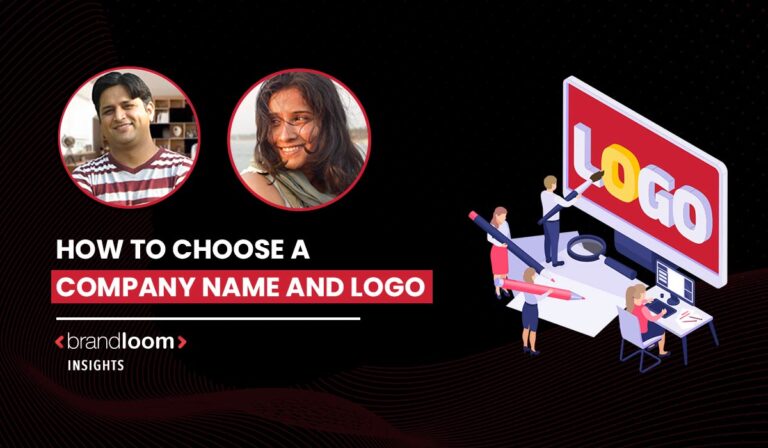Shakespeare once said, “What’s in a name?” When it comes to building a brand, the answer is – A LOT. The name you choose for your company goes a long way in making it memorable and relatable to your audiences. In other words, there’s an art (and some science) to how to choose a company name and logo and build a brand for ages.
Side note: It’s great if you can find the perfect name for your company by yourself. If you feel like you need a little bit of help, Team BrandLoom’s brand consultants are always there.
So let’s get started.
What makes a good brand name?
Think of the biggest brands in any industry. There’s Nike, Starbucks, Netflix, Amul, Dettol, Whole Foods, Ikea, Ferrari, and many more. Believe it or not, they have a lot in common when it comes to their names. We scoured hundreds of heavyweight brand names and identified what makes them click.
1. Simple & easy to pronounce
Ever heard of Klynveld Peat Marwick Goerdeler? It’s the complete form of the Big Four behemoth KPMG. Now, imagine putting up a signboard with the full name. Or creating a website with that URL. You can’t- because when your name is this long and prohibitively complicated, it will automatically put people off.
In real life, people often avoid furthering acquaintance with someone whose name they cannot pronounce. The same happens with brands, too. A simple, easy-to-spell brand name is always more inviting and memorable.
This is doubly so in the internet age- where you’ll also have to create a website with the same name. So, choose a name that’s short and sweet.
2. Memorable
How to choose a memorable company name? There is really no fixed answer to it, but making it simple and easy to pronounce is the first step towards it. Second, ensure your brand name explains or hints at some meaning. People tend to remember names that give them an idea about what the company is doing.
For example, “Netflix” in itself has no meaning, but immediately tells you what the brand provides. The name combines “net” for internet, and “flix” for flicks – the other word for movies. The moment you hear it, you know that this brand probably uses the internet to show you movies.
Use alliterations or familiar-sounding words to make your brand name more memorable. Miu Miu used the pet name of its founder, Miuccia Prada, to create a memorable name. It also helps that it sounds like a “meow,” which is familiar to everyone across the world.
3. Not too literal
When you are too literal or obvious with your name, you limit your brand’s potential. When you name your business “Tarun’s Teacups”, it may sound great on paper, but it pigeonholes you. Tomorrow, if you want to sell coffee mugs or wine glasses, you must rethink your name. So, never be too obvious, and avoid talking about a single product/ service in your name.
4. Be Unique, not generic
If you stand out, you have a fair chance of being remembered. So, avoid generic names. One prevalent example of this is the word “Ayur,” which is used by every other brand in the wellness industry who have natural products. The overused prefix just makes your brand forgettable.
On the other hand- how good is the name “Banyan Botanicals” for wellness supplements? It gives a nod to its debt to ancient Indian wisdom without alluding to ayurveda, and creates an alliterative name that’s immensely memorable.
Be unique. Here’s how to choose a non-generic company name:
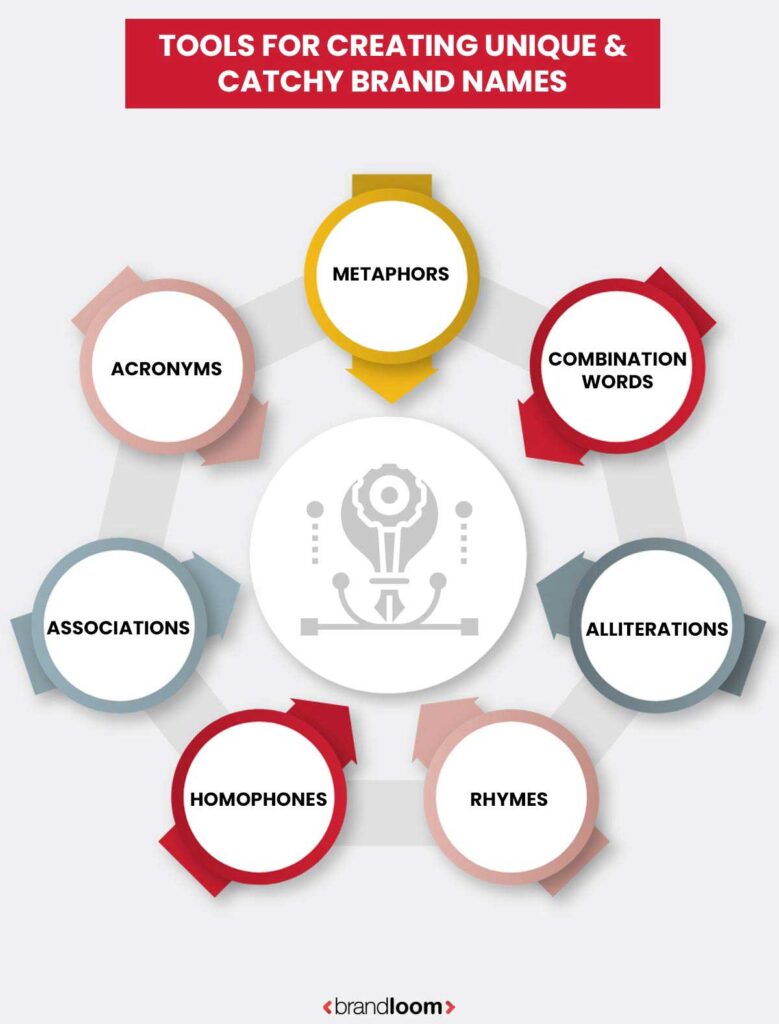
Metaphors
A name does not have to be literal- it can represent something. Think of Amazon- the global giant that has EVERYTHING. It takes its name from the world’s largest rainforest, which is home to one the richest ecosystems and seems endless. Similarly, Oracle’s name does not directly indicate what it is- but alludes to the mystical and authoritative entities that have guided people through ages with their answers.
Combination words
Combine two or more words to come up with something unique & memorable. Netflix, Facebook, and Starbucks are good examples of companies with distinctive brand names that combine multiple words.
Alliterations
Alliteration or repetitive sounds (like Tintin) are inherently memorable. We already saw a good example in Miu Miu. Some others are- Coca-Cola, Best Buy, PayPal, and TikTok.
Rhyme
Rhymes are memorable and simple. You can use rhyming words to create a good name, like GrubHub, Loco Poco, and Reese’s Pieces.
Homophones
Words that sound like another instantly build recall, and are very handy when it comes to trademarking. Think of Lyft, Reddit, or Grindr.
Associations
Leverage associations to create something unique. Instead of being literal, highlight a symbolic aspect of the brand. For example, Windows does not sound very technological. But it highlights that it’s the key to looking at, exploring, and discovering matters of interest- and opportunities.
Acronyms
IKEA, KPMG, HBO, ITC- some of the biggest brands in the world use acronyms for their names. Acronyms are inherently memorable, but the trick is to keep them short and catchy. We recommend never going beyond 4-5 letters. If you can create an acronym that can be pronounced easily or sounds familiar, it’s even better.
Of course, when you create a brand name, always check availability to ensure you’re not coming across as a copycat or courting legal trouble.
Now that you have the basics cleared, let us dive deep into how to pick a company name and logo. Because a good name goes beyond being catchy – it stands for something, and conveys the values it embodies.
So, start by clarifying the brand you want to build.
How to create a good brand name?
1. Know your promise
What is it that you’re offering beyond the product? Your brand name can convey your promise. For example, “Moov”. It does not say openly that it’s for pain relief, but it tells you it will help you stay mobile and able. It immediately registers and tells audiences what to expect.
2. Check out the competition.
You define yourselves by differentiating yourself. So, what makes you uniquely YOU? It is your brand’s promise. That’s what sets you apart from the competitors. Figure out your USP & personify it in your name. For example, Nike urges people to be their best selves and hit their goals. They personified it by taking the name of the Greek goddess of victory- which articulates their promise right away.
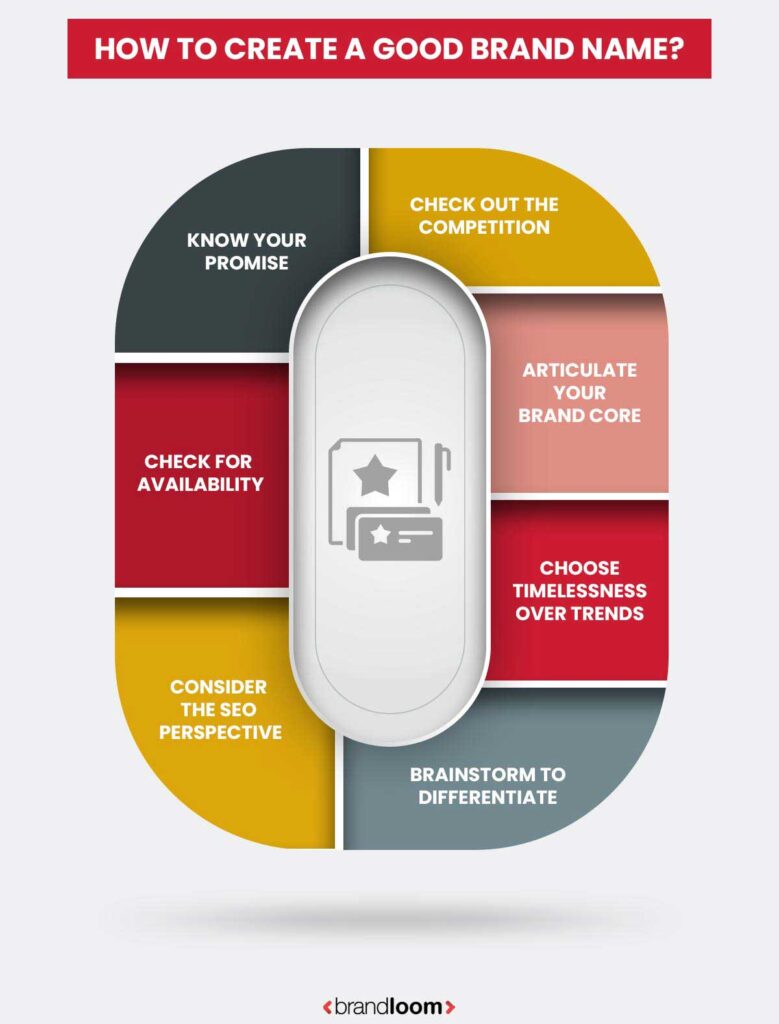
3. Articulate your brand core.
Your brand’s name is the manifestation of your brand’s promise, values, and personality. So, figure out your brand’s timeless, defining core first. Chalk out the following:
- Brand story
- Mission
- Vision
- Positioning statement
- Values
- Personality traits.
Now, think of the best word that encapsulates this entity. As we have said, it can even be a made-up word.
For example, Tesla is named after a genius who revolutionized the electrical supply system. At the same time, Duo Lingo clearly communicates that it helps people learn other languages.
4. Choose timelessness & vision over trends
Remember- while trends and fads die quickly, a brand is forever. Many startups go for overtly trendy names, and their brand appears dated as soon as the trend vanishes. Think of “Salt Bae”. It’s a personal brand named after a meme. Turkish chef Nusret Gökçe has leveraged his internet fame to open luxury steakhouses. Since then, the brand has been mired in controversies, and many of its restaurants are in poor health as they are not seeing sales.
5. Brainstorm to differentiate
This is where you get creative. Acronyms, metaphors, inspirations, origins, values, word combos, homophones- look at all possible ways you can represent your brand best. And if you need help, we have a great team who can do it for you.
5. Look at it from SEO perspective
Ultimately, in the digital world, your brand will inevitably have to be online. So, go for brand names that are good for creating web domains. Too long or complicated names don’t lend themselves to good URL structures.
6. Check for availability
And finally- it’s time to check if your dream name can be yours or not. If yes- congrats! Good luck on your new journey. If not- it’s back to the drawing board.
Once you get your new brand name, it’s time to register it. Talk to a lawyer who can guide you through the process and ensure everything is sorted out before making your business live.
Pro tip: Think of the tagline in conjunction.
If you don’t want one, don’t stress it. Some of the biggest brands in the world- Netflix, Starbucks, Infosys, Google, Rolex, Whole Foods- don’t have taglines either.
However, if you choose a tagline, be ready to revise it. A brand is always a work in progress; as the world changes, its direction changes too. Your tagline can encapsulate that evolution succinctly and memorably. Very few companies have come up with taglines that have been truly timeless, like Nike’s Just Do It or Amul Butter’s Utterly Butterly Delicious. So, even if you choose (and copyright) your tagline, be open to updating it.
Now, you’re ready with your brand name. The next step- creating its identity markers. You need to create a logo as the main visual representation of the brand. When your brand is strong- you don’t even have to use its name, just the logo or symbol will do (think of the iconic Nike swoosh).
So let’s do it.
Creating a Brand Logo
If you want to create a logo, you don’t just use a random symbol. A logo is a carefully crafted strategic identity marker and your brand’s most important visual element. Think of the apple with a bite or the Starbucks siren. Most market leaders’ logos are instantly recognizable and communicate strategically.
To create the perfect logo for your brand, do your homework. Here are the factors you must consider before you start sketching:
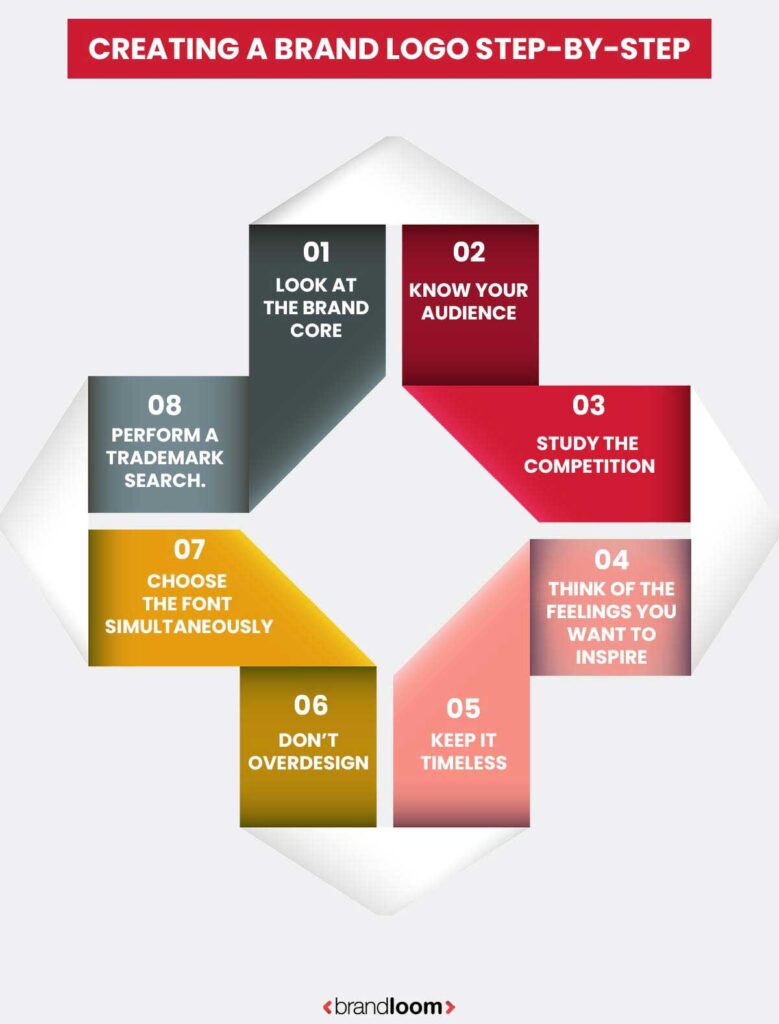
1. Look at the brand core
Who are you and what do you stand for? Your logo should hint at your brand’s promise, invoke feelings, or urge action. Think of how you can embody your brand’s positioning and whether it will render well across all surfaces. Remember, in the internet age, your logo will be placed on digital and physical surfaces. Consider your collaterals, packaging, and virtual assets, and ensure you choose the right type of logo that can communicate clearly everywhere.
Look at Nike’s famous swoosh symbol. The brand that asks people to “just do it” uses a swoosh symbol like you checking off something on a to-do list.
2. Know your audience
Everything in the world of branding and marketing is about communicating with the target audience. So when you create a logo- understand what will appeal to them. For those looking for a bit of a happy little meal- a logo rendered in bright red and yellow may be the right choice. Similarly, when your audience is looking for finesse and sophistication- it makes sense to create a simple and elegant silver logo like Mercedes has.
3. Study the competition
You are what others are not. So when you create a logo- don’t make it too similar to your rivals. Otherwise, your logo will feel generic. However, make sure you don’t make a logo that feels like it represents an entirely different industry.
For example, if you have a financial institution logo in pastel shades, it will look incongruous.
However, this doesn’t mean that the industry determines everything about what your logo should be. Your logo should finely balance your brand story, vision, industry conventions & audience appeal.
4. Think of the feelings you want to inspire.
What do you want people to feel? If it’s a sense of calmness, probably choose aqua shades and circles. Want your logo to inspire hunger? Go for vivid colors (most fast food chains follow this) like red, yellow, orange, and green. Want to appeal to the senses? Rich jewel tones in tactile textures can be your best friend.
Think of the deep, trustworthy blue of SBI or the attention-grabbing Netflix red with sharp angles. The best logos are built on a good understanding of human psychology.
Choose the correct type of logo.
Now, you have to choose what type of logo will work best for your brand.
Wordmark
Spell out the name of your brand in an eye-catching font. Think of Coca-Cola or Visa. They work great for startups because they help in gaining visibility by using the full name.
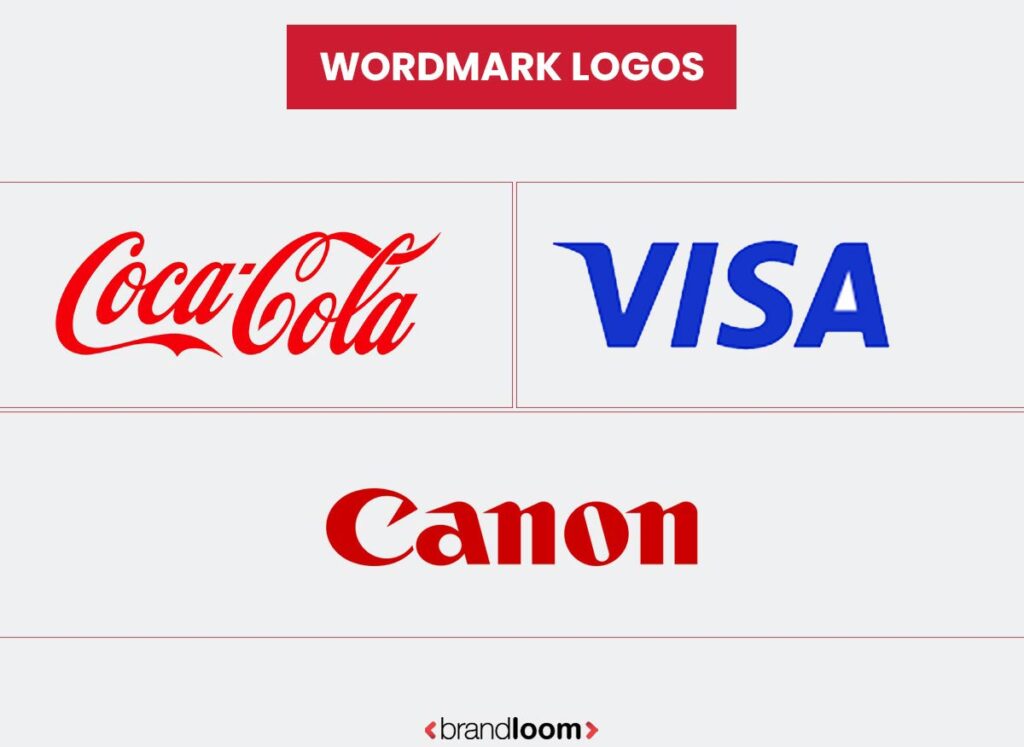
Lettermark
Monograms or lettermarks are also typography based, but they usually only use initials. Think of HBO, BBC or IKEA. Lettermarks are very common in the media industry.
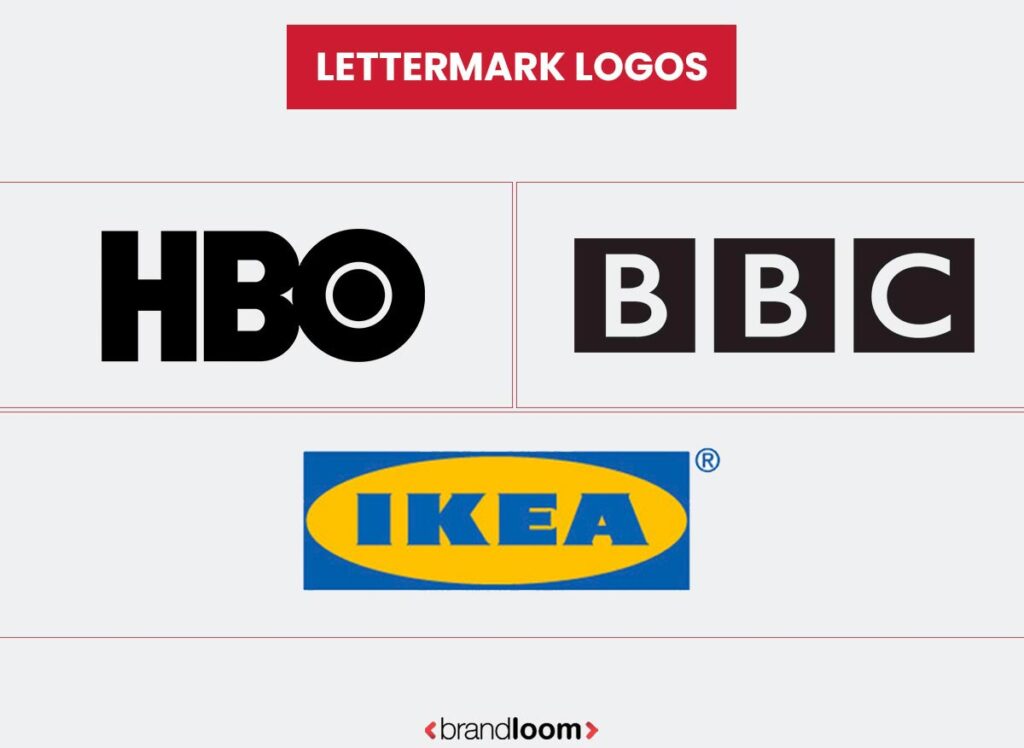
Pictorial
This is for brands that enjoy a high recall and don’t need to flash their full name at you. Instagram, Apple, and Target are some great examples. Painstakingly designed to communicate clearly and simply, they are highly original
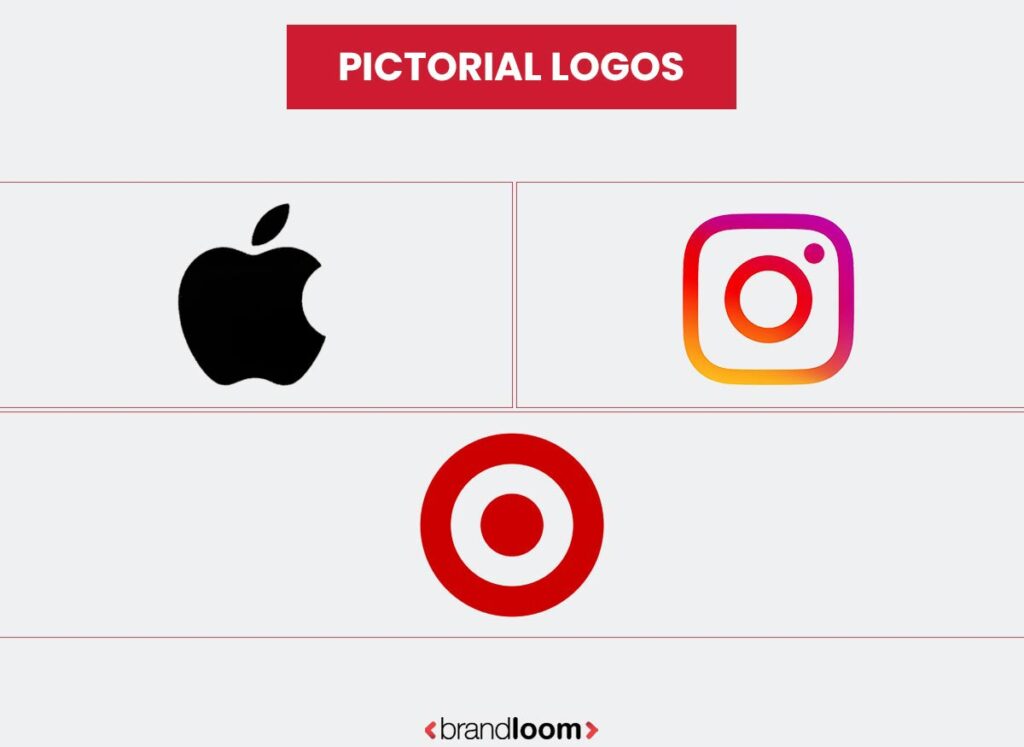
Abstract
These are highly creative logos that may often rely on symbolism. Think of the Windows four-paned logo or the starburst BP logo. Not recommended for startups or brands that are still struggling.
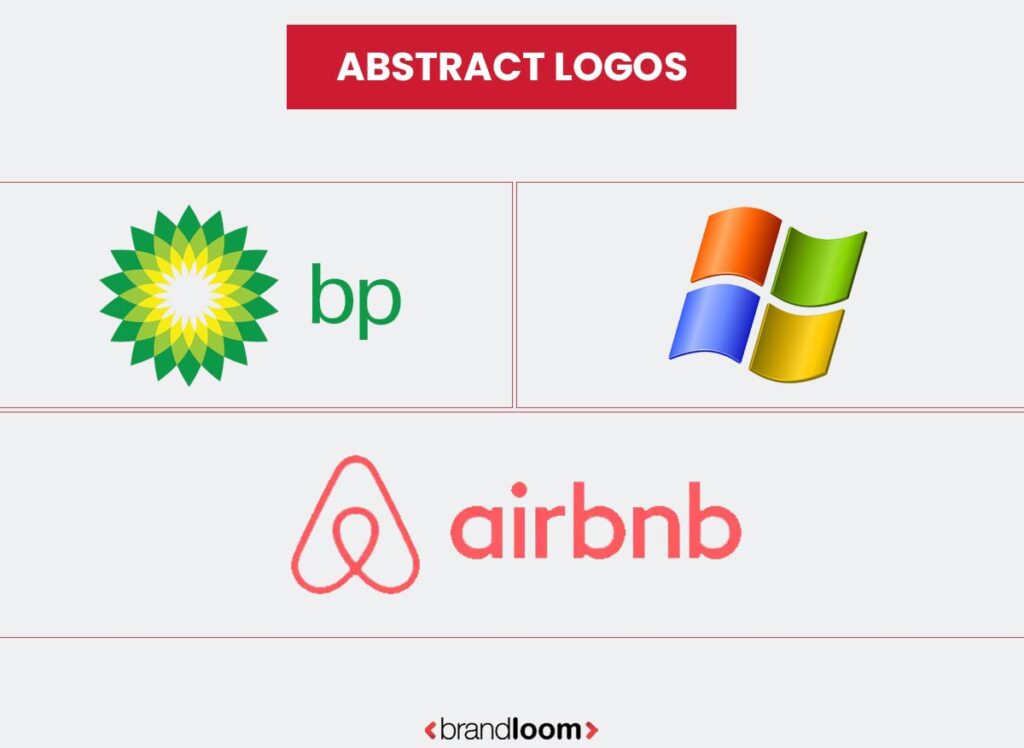
Emblems
Logos that proudly proclaim heritage, cult followings, and prestige, just like the aristocratic seals or badges they take inspiration from. Most educational institutions, such as Harvard University, use emblem logos. On the other hand, cult brands like Starbucks or Harley-Davidson also use them.
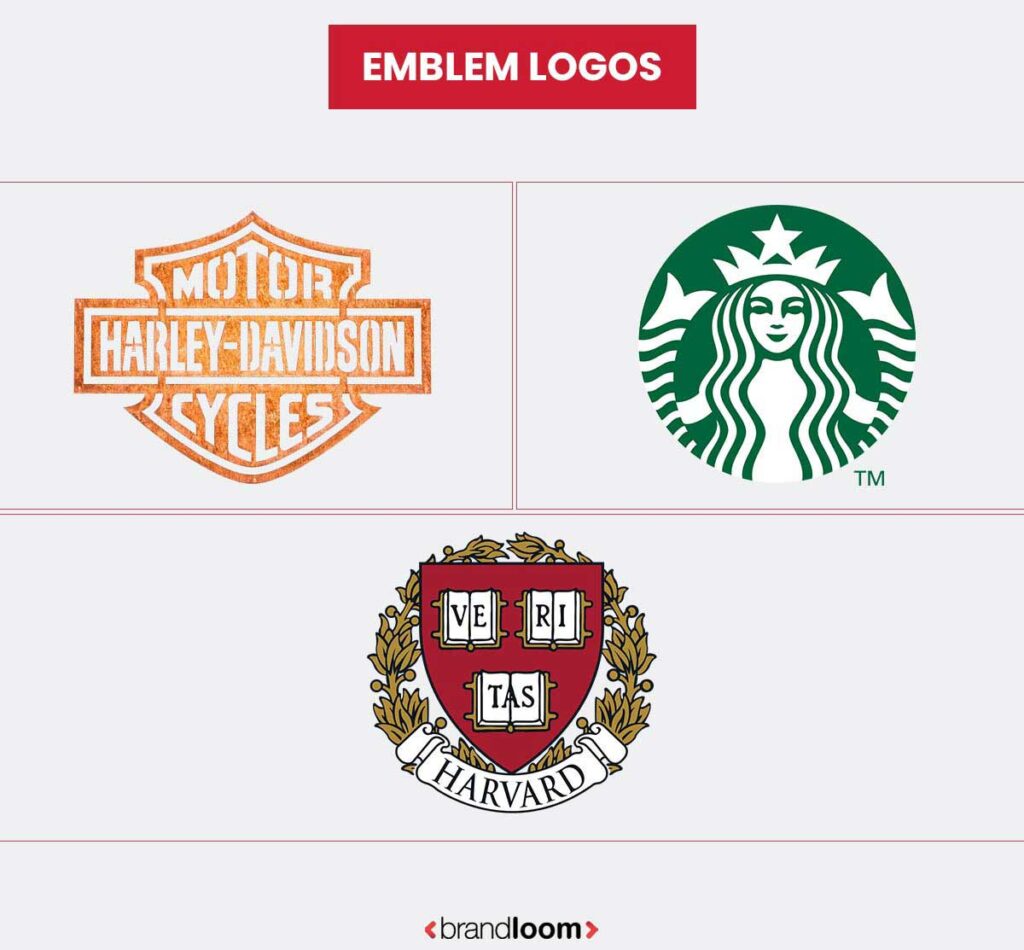
Mascots logotype
As the name suggests, you can create a logo with a mascot or a character. Think of Col. Sanders of KFC, the Michelin tire man, or the winking monkey from Mailchimp. Mascots can be a good option for brands that want to give a family-friendly or welcoming feeling.
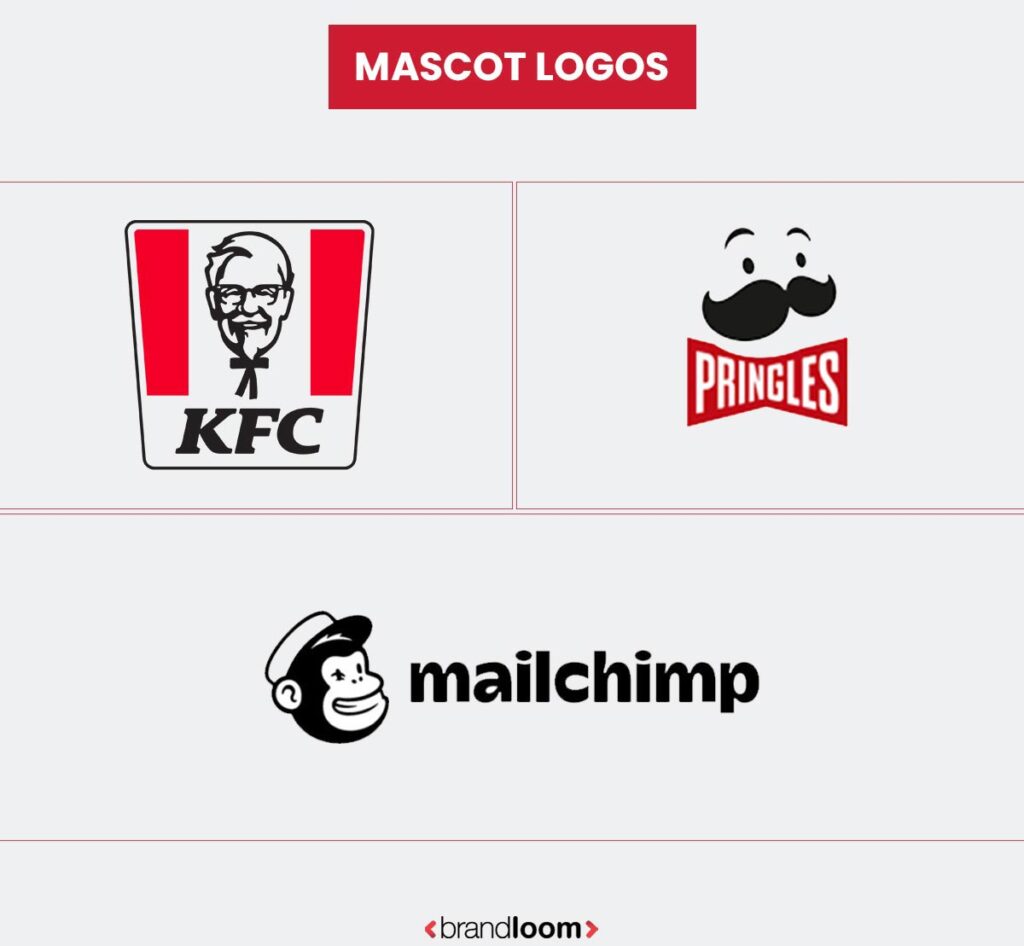
Combination mark
As the name suggests, these logos are created by combining both images and pictorial elements. They are the easiest to trademark because the combination of two different facets makes your logo less likely to be copied. They are versatile and impactful because they create a distinct image in the audience’s mind. This is why they remain popular across industries. Think of Adidas or Burger King.
If you want to know more about the different types of logos, read our detailed blog.
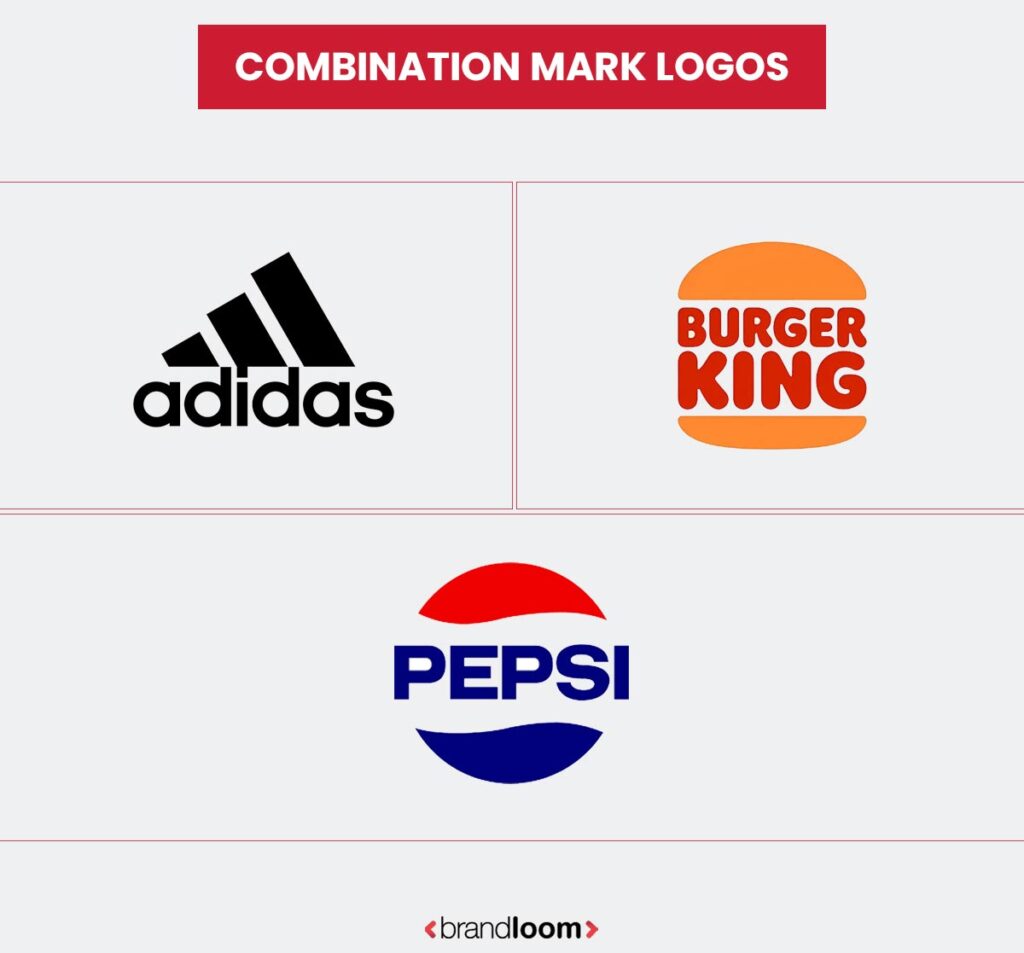
5. Keep it timeless
Like your brand name, your logo should also be timeless. During the early 2000s, many brands went through a “transparent 3D” phase. The most prominent ones were Xbox, Apple, and Microsoft. Before long, the trend was saturated, and brand owners discovered that rendering 3D logos across surfaces was not easy. When we look at them today, they look incredibly dated. So, instead of unthinkingly following trends, choose something classic and timeless.
6. Don’t overdesign
Simplicity is the key to good communication. A logo that’s too detailed or intricate will not be suitable for all surfaces or sizes, and can appear off-putting. Just think of the old-style medieval fonts, or logos with handwritten names. They don’t register easily with the human brain, and may feel illegible and unappealing.
7. Choose the font simultaneously.
Of course, no matter what your logo is, your font will be a part of it. So, choose the font simultaneously to ensure it complements your pictorial elements and vice versa. Just look at the iconic “Barbie” logo and imagine it with an IBM-style straight-laced font. It just won’t work.
8. Perform a trademark search.
Now comes the final step- figuring out whether it’s unique. Do a trademark search and see what options are available. Avoid designs that look similar to existing or registered ones. Otherwise, you may land in hot water.
Reminder: It’s not a zero-sum game. All the factors we listed above- don’t mistake one single aspect to be enough to determine your logo’s character. Brainstorm carefully and try to balance all the necessary precursors to create something that pops, is practical, and memorable.
Conclusion
So, now you have a good idea about how to create a good name and logo for your business. We believe that every brand out there deserves to shine- and we hope our guide was helpful. Give our methods a try- and if you find it overwhelming, we have some good brand consultants and logo designers who can take it off your hands.
Frequently Asked Questions
If you want to choose a company name and logo in India, follow these easy steps:
Keep it easy & clear: whether it’s your name or logo, clarity trumps cleverness every time. The easier it is on the eyes and ears, the more likely it is to build recall.
Timelessness over trends: trends come and go- your brand and its markers are forever.
Be unique: study the market and competition to come up with something distinct & memorable.
Embody your story & positioning: what does your brand stand for? Reflect its philosophy and direction in your name and logo.
Appeal to audiences: choose a name and a symbol that will click with them and invoke strong feelings.
Of course, choosing a brand name and logo requires a more nuanced approach than we can encapsulate in a list. So, if you want help in that department, talk to our strategic identity consultants.
You cannot copyright a company name and logo in India, but you can protect them under trademark law. Before applying for a trademark, do your research.
Use the official IP India website: https://tmrsearch.ipindia.gov.in/tmrpublicsearch/frmmain.aspx.
Search under Wordmark (for name) and Class.
Ensure that your name or logo does not look overtly similar to existing ones.
Talk to a lawyer specializing in trademark laws for a smooth journey. Submit your application and be prepared if the Examiner places any objections on it.
Creating a company name and logo is not easy, and the result must be strategic.
Audit your competition: Know who you’re up against. Check what their messaging is and how they are embodying it. This will help you set yourself apart.
Understand your audience: “EVERYONE” cannot be your audience. So map your customer personas carefully. Understand what they will respond to.
Decide what you want your audience to feel: A brand is a feeling and a promise, so be clear what you want your audience to think and feel when they look at, hear about, or think about your brand. Trust? Sense of relief? Anticipation? Happiness? Reverence? Choose accordingly.
Figure out your brand core: Your name and logo merely manifest your core. Carefully chalk out your brand story, mission, vision, positioning statement, and values. Now, brainstorm what aspects you want to be defined by, and represent them in your name and logo.
Keep it memorable & straightforward: Choose timeless names and designs over “clever” ones, and simple ones over trendy ones. Your brand’s identity markers should be clear about your message to register with people.
Test them out: Go for focus groups to figure out how people may react to your name and logo. If you don’t get the reaction you were hoping for, it’s time to redo them.
Finalize & trademark: Once your name and logo look shipshape and ready to go, protect them. In India, you cannot copyright them, but can trademark them.
Of course, creating your brand’s two main strategic identity markers- its name and logo, requires an expert touch. Our brand consultants and logo designers can do just that.
In India, you must protect your brand name or logo with a trademark registration. The process involves submitting Form TM-A to the Trademark Office, and specifying the correct class for your goods or services. Following the registration, you can use the ® symbol. Under the Trademark Act of 1999, your trademark will be valid for 10 years and have to be renewed after it expires.
It is best to take the advice of a legal expert to ensure your brand name is registered the right way, so that you can protect it and legally defend it where needed.
A brand name is the name given to a company which markets certain goods or services. It is the primary identity of a marketable entity. Its purpose is to help companies, people and authorities identify and differentiate a company, product or person. A good brand name helps companies connect with their audiences and build recall, and eventually, associate certain strong feelings or values with it.
Some examples of instantly recognizable brand names are- Amul, McKinsey, Lifebuoy, HBO, Pantene, etc. If you want to build a business, the first step is to get a good name for it. Team BrandLoom’s brand consultants can get you exactly what you need- so, talk to us!
In order to check your brand name availability- do 3 important searches.
Google search: figure out if any company is already registered with the name you selected, especially in your industry. Different brands can have the same name if they operate in different fields. For eg, Firefox is a popular browser, and also the name of a brand of cycles.
Check for your wordmark after specifying the class at the official IP India website: https://tmrsearch.ipindia.gov.in/tmrpublicsearch/frmmain.aspx.
Look at availability of domain name search on godaddy or wix or other such platforms.
If the name you have in mind passes all three checks, then congrats! Otherwise, try tweaking the spelling. If that doesn’t work either- then it’s time to get back to the drawing board.
To register a company logo in India, follow this step-by-step guide:
Create a unique brand name and logo: If you need help, Team BrandLoom’s logo designers are here for you.
Apply for your brand name along with the logo, as soon as possible.
Get it approved by the examiner’s office as soon as you can.
After you get an approval, your trademarks will be published in the Trademarks Journal- which is the directory for old and new company name lists. Within four months, the registrar will process it.
If there is no third-party objection to your logo after being published in the journal- a registration certificate under the seal of the trademark would be issued.
The whole process may take 12-18 months. To ensure you have all the documents needed, or that everything is in order, take the help of a legal expert.
A logo is your business’ biggest visual marker, so choose it carefully. Now, while a lot will depend on your brand story, market specifications and the emotions you want to invoke- here are some tips about choosing the right type of logo for your businesses:
Wordmark: Best for startups as they spell out the name in an eye-catching font and color. Eg: Coca-Cola, Amazon Prime.
Lettermark: Monograms that work really well for established brands, or brands that have acronyms for names. Popular in the media industry. Eg: HBO, IKEA.
Emblem: For strong brands with cult followings or those that want to claim prestige. Popular with educational institutes. Eg: Harvard University, Starbucks.
Pictorial: Brands with high recall who don’t even have to use their names to be recognized. For eg: Target, Apple.
Abstract: Not recommended for newbies. Used by established companies. Eg: Windows, BP.
Combination: The most common type of logo, and easiest type to register. Versatile in nature- combines both pictorial elements and the brand name. Eg: Taco Bell, Burger King.
Mascot: Used by brands that nurture team spirit, are welcoming and often family-friendly. Eg: Pringles, KFC.
Want to understand what type will suit YOU best? Talk to our brand consultants.
The slogan or tagline is often used along with a brand’s logo to describe what it offers, its values, or its promise. Think L’Oreal’s famous tagline, which appears along its logo- Because You’re Worth It. Or Nike’s “Just Do It” which appears beside its famous swoosh logo. Both of these are examples of iconic slogans which are as recognizable as their logos.
However, not all brands have to have a tagline. Netflix, Starbucks, DC, and HBO are famous market leaders that don’t use taglines.
For picking a company name and logo, you must first run through this checklist:
Is your brand name and logo-
– Simple and easy to remember?
– Timeless?
– Unique & distinct from competitors?
– Invokes the emotions you want your audiences to feel?
– Passing focus group tests?
– Available for trademarking?
If the answer to all of that is “yes”, CONGRATULATIONS. You may have hit the jackpot. Go ahead and start communicating with your audiences. Create your packaging, space designs, website, social media handles, and other branded collateral with it and test it out.
If you hit a snag with the checklist or find it too intimidating, call our brand consultants.

